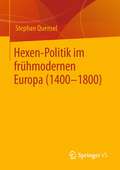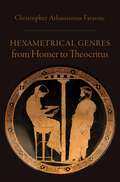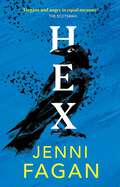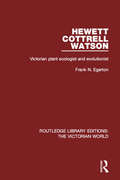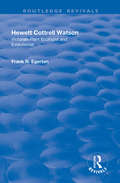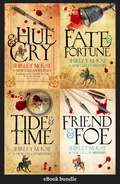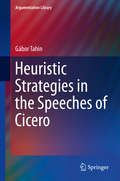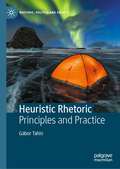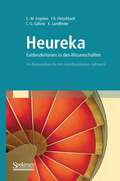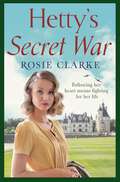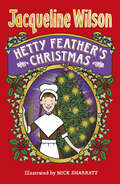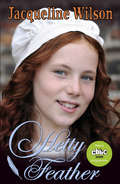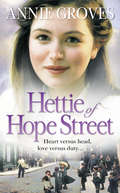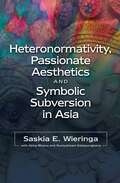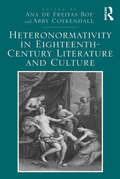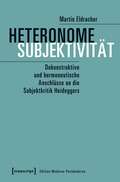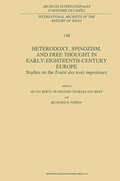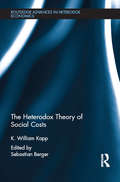- Table View
- List View
Hexen-Politik im frühmodernen Europa (1400 – 1800)
by Stephan QuenselWarum glaubt eine ganze Gesellschaft, dass es Hexen gibt, die man verbrennen muss? Welche Rollen übernahmen dabei jeweils der sich herausbildende ‚Staat‘, die Professionen der Kleriker und Juristen und das daran beteiligte Publikum? Und wie konnte dieses Projekt beendet werden?Aus soziologischer Sicht ergeben die Befunde der rezenten internationalen Hexen-Forschung ein Modell einer allgemeineren, höchst ambivalent besetzten, ‚pastoralen‘ Grundhaltung, nach der ein Hirte gleichermaßen für das Wohl seiner Herde wie für deren irrende Schafe zu sorgen habe.Der erste Hauptteil beschreibt die klerikale Ausgangs-Situation, die auf der Grundlage der noch immer dominierenden magisch-religiösen Mentalität im 15. Jahrhundert das ‚dominikanisch‘ dämonologische Hexen-Modell entwickelte.Ein Modell, so der zweite Teil des Buches, das dann im Laufe des 16. Jahrhunderts im westlichen Europa zunehmend in die Hände der gar nicht so unschuldigen Juristen geriet. Von dort entwickelte es sich zu einer juristischen Hexen-Verfolgung, die von der Dorf-Hexe über die Massenverfolgungen bis hin zu den späten Kinder-Hexen das früh-europäische Hexen-Modell realisierte.Der dritte Teil beschreibt, wie die Hexen-Verfolgungen gegen Ende des 17. Jahrhunderts als allgemeines Hexen-‚Politik‘-Spiel im Übergang vom Konfessions-Staat zum (Hof-)‚Beamten‘-Staat langsam an Bedeutung verloren.
Hexametrical Genres from Homer to Theocritus
by Christopher Athanasious FaraoneIn Hexametrical Genres from Homer to Theocritus, Christopher Faraone discusses a number of short hexametrical genres such as oracles, incantations and laments that do not easily fit the generic models provided by the extant poetry of Hesiod and Homer. In the process, he gives us new insight into their ritual performance, their early history, and how poets from Homer to Theocritus embedded or imitated these genres to enrich their own hexametrical poems--by playing with and sometimes overturning the generic expectations of their audiences or readers. Christopher Faraone combines literary and ritual studies to produce a rich and detailed picture of hexametrical genres performed publicly for gods, such as hymns or laments for Adonis, or other that were performed more privately, such as epithalamia, oracles, or incantations. This volume deals primarily with the recovery of lost or under-appreciated hexametrical genres, which are often left out of modern taxonomies of archaic hexametrical poetry, either because they survive only in fragments or because the earliest evidence for them dates to the classical period.
Hexametrical Genres from Homer to Theocritus
by Christopher Athanasious FaraoneIn Hexametrical Genres from Homer to Theocritus, Christopher Faraone discusses a number of short hexametrical genres such as oracles, incantations and laments that do not easily fit the generic models provided by the extant poetry of Hesiod and Homer. In the process, he gives us new insight into their ritual performance, their early history, and how poets from Homer to Theocritus embedded or imitated these genres to enrich their own hexametrical poems--by playing with and sometimes overturning the generic expectations of their audiences or readers. Christopher Faraone combines literary and ritual studies to produce a rich and detailed picture of hexametrical genres performed publicly for gods, such as hymns or laments for Adonis, or other that were performed more privately, such as epithalamia, oracles, or incantations. This volume deals primarily with the recovery of lost or under-appreciated hexametrical genres, which are often left out of modern taxonomies of archaic hexametrical poetry, either because they survive only in fragments or because the earliest evidence for them dates to the classical period.
Hex: Darkland Tales (Darkland Tales #2)
by Jenni FaganA powerfully poignant tale of one of the most turbulent moments in Scotland's history: the North Berwick Witch Trials.IT’S THE 4TH OF DECEMBER 1591.On this, the last night of her life, in a prison cell several floors below Edinburgh’s High Street, convicted witch Geillis Duncan receives a mysterious visitor – Iris, who says she comes from a future where women are still persecuted for who they are and what they believe.As the hours pass and dawn approaches, Geillis recounts the circumstances of her arrest, brutal torture, confession and trial, while Iris offers support, solace – and the tantalising prospect of escape.Hex is a visceral depiction of what happens when a society is consumed by fear and superstition, exploring how the terrible force of a king’s violent crusade against ordinary women can still be felt, right up to the present day. 'This series has already produced two works of note and distinction. It raises the question – if a country cannot re-tell its history, will it be stuck forever in aspic and condemned to be nothing more than a shortbread tin illustration? Hex and Rizzio are showing the way towards a reckoning, and about time too’ – Stuart Kelly, Scotland on Sunday
Hewett Cottrell Watson: Victorian Plant Ecologist and Evolutionist (Routledge Library Editions: The Victorian World)
by Frank N. EgertonFirst published in 2003. Hewett Cottrell Watson was a pioneer in a new science not yet defined in Victorian times – ecology – and was practically the first naturalist to conduct research on plant evolution, beginning in 1834. The correspondence between Watson and Darwin, analysed for the first time in this book, reveals the extent to which Darwin profited from Watson’s data. Darwin’s subsequent fame, however, is one of the reasons why Watson became almost forgotten. This biography traces both the influences and characteristics that shaped Watson’s outlook and personality, and indeed his science, and the institutional contexts within which he worked. At the same time, it makes evident the extent of his real contributions to the science of the plant ecology and evolution.
Hewett Cottrell Watson: Victorian Plant Ecologist and Evolutionist (Routledge Library Editions: The Victorian World)
by Frank N. EgertonFirst published in 2003. Hewett Cottrell Watson was a pioneer in a new science not yet defined in Victorian times – ecology – and was practically the first naturalist to conduct research on plant evolution, beginning in 1834. The correspondence between Watson and Darwin, analysed for the first time in this book, reveals the extent to which Darwin profited from Watson’s data. Darwin’s subsequent fame, however, is one of the reasons why Watson became almost forgotten. This biography traces both the influences and characteristics that shaped Watson’s outlook and personality, and indeed his science, and the institutional contexts within which he worked. At the same time, it makes evident the extent of his real contributions to the science of the plant ecology and evolution.
Hewett Cottrell Watson: Victorian Plant Ecologist and Evolutionist
by Frank N. EgertonThis title was first published in 2003. Hewett Cottrell Watson was a pioneer in a new science not yet defined in Victorian times - ecology - and was practically the first naturalist to conduct research on plant evolution, beginning in 1834. His achievement in British science is commemorated by the fact that the Botanical Society of the British Isles named its journal after him - Watsonia - but of greater significance to the history of science is his contribution to the development of Darwin’s theory of evolution. The correspondence between Watson and Darwin, analysed for the first time in this book, reveals the extent to which Darwin profited from Watson’s data. Darwin’s subsequent fame, however, is one of the reasons why Watson became almost forgotten. At the same time, Watson can be called a classic Victorian eccentric, and his other ambition, in addition to promoting and organizing British botany, was to carry forward the cause of phrenology. Indeed, he was a more daring theoretician in phrenology than ever he was in botany, but in the end he abandoned it, not being able to raise phrenology to the level of an accepted science. This biography traces both the influences and characteristics that shaped Watson’s outlook and personality, and indeed his science, and the institutional contexts within which he worked. At the same time, it makes evident the extent of his real contributions to the science of plant ecology and evolution.
Hewett Cottrell Watson: Victorian Plant Ecologist and Evolutionist (Routledge Library Editions: The Victorian World Ser.)
by Frank N. EgertonThis title was first published in 2003. Hewett Cottrell Watson was a pioneer in a new science not yet defined in Victorian times - ecology - and was practically the first naturalist to conduct research on plant evolution, beginning in 1834. His achievement in British science is commemorated by the fact that the Botanical Society of the British Isles named its journal after him - Watsonia - but of greater significance to the history of science is his contribution to the development of Darwin’s theory of evolution. The correspondence between Watson and Darwin, analysed for the first time in this book, reveals the extent to which Darwin profited from Watson’s data. Darwin’s subsequent fame, however, is one of the reasons why Watson became almost forgotten. At the same time, Watson can be called a classic Victorian eccentric, and his other ambition, in addition to promoting and organizing British botany, was to carry forward the cause of phrenology. Indeed, he was a more daring theoretician in phrenology than ever he was in botany, but in the end he abandoned it, not being able to raise phrenology to the level of an accepted science. This biography traces both the influences and characteristics that shaped Watson’s outlook and personality, and indeed his science, and the institutional contexts within which he worked. At the same time, it makes evident the extent of his real contributions to the science of plant ecology and evolution.
The Hew Cullan Mysteries: eBook Bundle (The\hew Cullan Mysteries Ser. #1)
by Shirley McKay1579, St Andrews. When Hew Cullan, a young lawyer, returns home after studying in Paris, he arrives to find a close friend accused of murdering a thirteen-year-old boy. For the first time, Hew finds himself plunged headlong into a Pandora’s box of lies and deception, starting his journey as a reluctant mystery solver. From the chilling austerity of university life to the shores of Flanders and the court of King James, Hew must unravel the subterfuge and murder that pervades sixteenth-century Scotland.This bestselling series is a must-read for fans of thrilling historical fiction, expertly researched and utterly enthralling.Titles included in this bundle are:Hue & CryFate & FortuneTime & TideFriend & Foe
Heuristic Strategies in the Speeches of Cicero (Argumentation Library #23)
by Gábor TahinThis book introduces a new form of argumentative analysis: rhetorical heuremes. The method applies the concepts of heuristic thinking, probability, and contingency in order to develop a better understanding of complex arguments in classical oratory. A new theory is required because Greek and Roman rhetoric cannot provide detailed answers to problems of strategic argumentation in the analysis of speeches. Building on scholarship in Ciceronian oratory, this book moves beyond the extant terminology and employs a concept of heuristic reasoning derived from the psychology of decision making and mathematical problem solving. The author analyses selected passages from Cicero’s forensic speeches where arguments of probability are deployed, and shows that the Sophistic concept of probability can link ancient rhetoric and modern theories of argumentation. Six groups of heuremes are identified, each of which represents a form of probabilistic reasoning by which the orator plays upon the perception of the jurors.
Heuristic Rhetoric: Principles and Practice (Rhetoric, Politics and Society)
by Gábor TahinThis book introduces a novel approach to the analysis and practice of persuasive speaking and writing: heuristic rhetoric. The new method has evolved to fulfil the need at universities, government departments, political organisations, business enterprises and other public institutions for a modern practical alternative to classical rhetoric, which is, in the author’s view, no longer capable of giving a complete description of contemporary, predominantly mediatised, forms of public persuasive discourse, whilst other competing disciplines, such as critical discourse analysis or strategic manoeuvring, have not yet produced a set of tools, which have the comprehensive nature and practical orientation of Classical Greek and Roman rhetorical system. The book expounds heuristic rhetoric as an inter-disciplinary method to develop advanced skills of critical and strategic reasoning. Applying a novel set of principles for the strategic analysis of persuasive reasoning in complex rhetorical situations, the method emphasizes preparing and continuously adjusting argumentation according to the demands of unpredictable circumstances.
Heureka - Evidenzkriterien in den Wissenschaften: Ein Kompendium für den interdisziplinären Gebrauch
by C. Giovanni Galizia Katharina Landfester Eva-Maria Engelen Christian Fleischhack"Heureka” (ich habe es gefunden) soll Archimedes gerufen haben, als er in der Badewanne lag und sah, wie sein Körper das Wasser verdrängte. Unvermittelt war ihm der Zusammenhang klar, er hatte das Auftriebsgesetz verstanden, was ihm dazu verhalf, den Goldgehalt der Krone des Tyrannen zu bestimmen. Er entstieg der Wanne, rannte nackt durch die Straßen von Syrakus und rief weiterhin „ich habe es gefunden!“ Wie werden in einzelnen Disziplinen Heureka-Effekte hervorgerufen? Wann leuchtet Wissenschaftlern in einem Fach ein Argument, ein Gedanke ein, wie werden sie davon überzeugt? Was sind die disziplinären Standards und wie sieht die Praxis im akademischen Alltag dazu aus? 15 Wissenschaftlerinnen und Wissenschaftler aus den Natur-, Geistes- und Sozialwissenschaften geben hierauf ihre Antworten in einer verständlichen und gut zugänglichen Weise.
Hetty's Secret War: A heartbreaking story of love, loss and courage in World War 2 (Women at War Series #3)
by Rosie ClarkeIn 1939, with the world on the brink of war, one women faces a future more uncertain than she had ever imagined... Perfect for fans of Katie Flynn and Cathy Sharp. Georgie - when the man she has always loved is sent to France on a secret war office mission every knock of the door fills her with dread of it being the feared telegram boy... Beth - orphaned as a child, Beth is coming of age and determined to do her bit for the war effort. Caught up in a whirlwind romance, she marries only to become a war widow... and one expecting a baby who will never know his brave father. Can she find happiness again? Hetty - desperately trying to make her way back from Paris to her beloved family in England, a fateful and tragic encounter brings Hetty to Chateau de Faubourg where she joins the resistance and risks both her heart and her life fighting for charismatic resistance leader Stefan Lefarge... However dark the times, courage, determination and the power of friendship can overcome the hardships of war.
Hetty Feather's Christmas (Hetty Feather #6)
by Jacqueline Wilson Nick SharrattAre you longing for Christmas? Can’t wait to warm yourself by the fireplace, drinking hot cocoa and toasting marshmallows? Hetty Feather’s festive story is bound to get you in the Christmassy mood!----------An unexpected gift leads to trouble for Hetty on Christmas Day at the Foundling Hospital, and the dreaded Matron Bottomly is delighted to have an excuse to exclude Hetty from the festive celebrations. Poor Hetty is distraught – but just when it seems that all is lost, a dear friend arrives to whisk her away for a Christmas unlike any other . . . Full of friendship, fun and festive cheer, this beautifully-packaged hardback is complete with stunning illustrations by Nick Sharratt and fabulous bonus material featuring fun facts about the Victorian Christmas.
Hetty Feather (Hetty Feather Ser. #1)
by Jacqueline WilsonThe mega-bestselling tale of fiery, spirited Victorian foundling, Hetty Feather.London, 1876. Hetty Feather is just a tiny baby when her mother leaves her at the Foundling Hospital. The Hospital cares for abandoned children - but Hetty must first live with a foster family until she is big enough to go to school. Life in the countryside is sometimes hard, but with her foster brothers, Jem and Gideon, Hetty helps in the fields and plays vivid imaginary games. Together they sneak off to visit the travelling circus, and Hetty is mesmerised by the show - especially the stunning Madame Adeline and her performing horses.But Hetty's happiness is threatened once more when she must return to the Foundling Hospital to begin her education. The new life of awful uniforms and terrible food is a struggle for her, and she desperately misses her beloved Jem. But now she has the chance to find her real mother. Could she really be the wonderful Madame Adeline? Or will Hetty find the truth is even more surprising? Jacqueline Wilson will surprise and delight old fans and new with this utterly original historical novel. The first book featuring feisty Victorian heroine, Hetty Feather, this is a compelling, moving, funny and totally fascinating tale that will thrill and captivate readers.
Hetty Feather (Hetty Feather #1)
by Jacqueline WilsonLondon, 1876. Hetty Feather is a tiny, fiery-haired baby when her mother leaves her on the steps of the Foundling Hospital. Sent to live with a foster family in the country until she is big enough to go to school, Hetty plays vivid imaginary games with her foster brothers. Together they sneak off to visit the travelling circus, and Hetty is mesmerised by the show - especially the stunning Madame Adeline and her performing horses.But Hetty's happiness is threatened when she must return to the Foundling Hospital to begin her education. The cruel matrons' strict regime is a terrible struggle for Hetty, and she desperately misses her beloved foster brother, Jem. But now she has the chance to find her real mother. Could she really be Madame Adeline? Or will the truth be even more surprising? An original, compelling and utterly fascinating tale from one of the most beloved writers of our time, and now a major CBBC series.
Hettie of Hope Street
by Annie GrovesA breathtaking tale set of one girl’s determination to triumph against the odds. From the bestselling author of Child of the Mersey and Home For Christmas.
Heteronormativity, Passionate Aesthetics and Symbolic Subversion in Asia (The Sussex Library of Asian & Asian American Studies)
by Saskia E WieringaThis book examines life trajectories among three categories of women living beyond the bounds of heteronormativity in Jakarta and Delhi, two major cities with substantively different religious and social values: women who have lost their husbands, either through divorce or death; sex workers; and young, urban lesbians. Delhi has a large Hindu majority and a sizeable Muslim minority, amongst other religious and cultural pluralities. The Indian state is constitutionally committed to secularism and equal respect to all regions despite right-wing Hindu fundamentalism. Jakarta is the capital of a sprawling archipelago with a large variety of ethnic cultures, Indonesia having the largest Muslim population of the world, as well as sizeable ethnic and religious minorities comprising Christians, Hindus, Buddhists and others. The Indonesian state is constitutionally secular, but religion plays a large role in public life and is embedded in regulations that strongly impact people's private lives. Recently, there have been strong political currents to impose stricter Islamic codes. The public arena of sexual politics, in which the media play an important role, is explored in both cities. Hot sex is a major media selling point, particularly in Indonesia. Heteronormativity entails a system of symbolic violence in the sense that it punishes those that it excludes and polices those that it includes; the ways its powers are subverted are likewise symbolic. Passionate aesthetics refers to the dynamics, motivations, codes of behavior and presentation, subjectivities and identities that together make up the complex workings of erotic attraction, sexual relations and partnerships patterns. By charting the lives of women who live beyond the boundaries of the heteronormative, commonalities are revealed; boundaries and regulatory mechanisms in the context of symbolic violence are delineated; and the issue of the struggle for sexual rights for marginalised groups, and their open rebellion, brought to the fore. At the heart of the book lies elaboration of the ways Asian families are constructed -- their social, economic, sexual and religious agency, and how these engage with state-led values.
Heteronormativity, Passionate Aesthetics and Symbolic Subversion in Asia (The Liverpool Library of Asian & Asian American Studies)
by Saskia E WieringaThis book examines life trajectories among three categories of women living beyond the bounds of heteronormativity in Jakarta and Delhi, two major cities with substantively different religious and social values: women who have lost their husbands, either through divorce or death; sex workers; and young, urban lesbians. Delhi has a large Hindu majority and a sizeable Muslim minority, amongst other religious and cultural pluralities. The Indian state is constitutionally committed to secularism and equal respect to all regions despite right-wing Hindu fundamentalism. Jakarta is the capital of a sprawling archipelago with a large variety of ethnic cultures, Indonesia having the largest Muslim population of the world, as well as sizeable ethnic and religious minorities comprising Christians, Hindus, Buddhists and others. The Indonesian state is constitutionally secular, but religion plays a large role in public life and is embedded in regulations that strongly impact people's private lives. Recently, there have been strong political currents to impose stricter Islamic codes. The public arena of sexual politics, in which the media play an important role, is explored in both cities. Hot sex is a major media selling point, particularly in Indonesia. Heteronormativity entails a system of symbolic violence in the sense that it punishes those that it excludes and polices those that it includes; the ways its powers are subverted are likewise symbolic. Passionate aesthetics refers to the dynamics, motivations, codes of behavior and presentation, subjectivities and identities that together make up the complex workings of erotic attraction, sexual relations and partnerships patterns. By charting the lives of women who live beyond the boundaries of the heteronormative, commonalities are revealed; boundaries and regulatory mechanisms in the context of symbolic violence are delineated; and the issue of the struggle for sexual rights for marginalised groups, and their open rebellion, brought to the fore. At the heart of the book lies elaboration of the ways Asian families are constructed -- their social, economic, sexual and religious agency, and how these engage with state-led values.
Heteronormativity in Eighteenth-Century Literature and Culture
by Ana de Boe Abby CoykendallThe resurgence of marriage as a transnational institution, same-sex or otherwise, draws upon as much as it departs from enlightenment ideologies of sex, gender, and sexuality which this collection aims to investigate, interrogate, and conceptualize anew. Coming to terms with heteronormativity is imperative for appreciating the literature and culture of the eighteenth century writ large, as well as the myriad imaginaries of sex and sexuality that the period bequeaths to the present. This collection foregrounds British, European, and, to a lesser extent, transatlantic heteronormativities in order to pose vital if vexing questions about the degree of continuity subsisting between heteronormativities of the past and present, questions compounded by the aura of transhistoricity lying at the heart of heteronormativity as an ideology. Contributors attend to the fissures and failures of heteronormativity even as they stress the resilience of its hegemony: reconfiguring our sense of how gender and sexuality came to be mapped onto space; how public and private spheres were carved up, or gendered and sexual bodies socially sanctioned; and finally how literary traditions, scholarly criticisms, and pedagogical practices have served to buttress or contest the legacy of heteronormativity.
Heteronormativity in Eighteenth-Century Literature and Culture
by Ana de Boe Abby CoykendallThe resurgence of marriage as a transnational institution, same-sex or otherwise, draws upon as much as it departs from enlightenment ideologies of sex, gender, and sexuality which this collection aims to investigate, interrogate, and conceptualize anew. Coming to terms with heteronormativity is imperative for appreciating the literature and culture of the eighteenth century writ large, as well as the myriad imaginaries of sex and sexuality that the period bequeaths to the present. This collection foregrounds British, European, and, to a lesser extent, transatlantic heteronormativities in order to pose vital if vexing questions about the degree of continuity subsisting between heteronormativities of the past and present, questions compounded by the aura of transhistoricity lying at the heart of heteronormativity as an ideology. Contributors attend to the fissures and failures of heteronormativity even as they stress the resilience of its hegemony: reconfiguring our sense of how gender and sexuality came to be mapped onto space; how public and private spheres were carved up, or gendered and sexual bodies socially sanctioned; and finally how literary traditions, scholarly criticisms, and pedagogical practices have served to buttress or contest the legacy of heteronormativity.
Heteronome Subjektivität: Dekonstruktive und hermeneutische Anschlüsse an die Subjektkritik Heideggers (Edition Moderne Postmoderne)
by Martin EldracherDie Kritik am autonomen, über sich verfügenden und sich selbst transparenten Subjekt, wie sie Martin Heidegger am entschiedensten ausgearbeitet hat, führte in der Mitte des 20. Jahrhunderts in der Philosophie zu einer Verabschiedung der Kategorie »Subjektivität«. Die Ironie dieser Situation liegt darin, dass gerade auf dem Boden einer solch umfassenden Kritik die Existenzweise von Subjekten und damit die Möglichkeit der Freiheit neu ausgelegt werden können. Martin Eldrachers Studie zeigt, wie sich erst im Anschluss an die Freilegung einer anarchischen Abhängigkeit Handlungsfähigkeit, Verantwortung und Selbstverständnis als zentrale Komponenten von Subjektivität überzeugend denken lassen.
Heterodoxy, Spinozism, and Free Thought in Early-Eighteenth-Century Europe: Studies on the Traité des Trois Imposteurs (International Archives of the History of Ideas Archives internationales d'histoire des idées #148)
by Silvia Berti Françoise Charles-Daubert R. H. Popkin'the oldest biography of Spinoza', La Vie de Mr. Spinosa, which in the manuscript copies is often followed by L'Esprit de M. Spinosa. Margaret Jacob, in her Radical Enlightenment, contended that the Traite was written by a radical group of Freemasons in The Hague in the early eighteenth century. Silvia Berti has offered evidence it was written by Jan Vroesen. Various discussions in the early eighteenth century consider many possi ble authors from the Renaissance onwards to whom the work might be attributed. The Trois imposteurs has attracted quite a bit of recent attention as one of the most significant irreligious clandestine writings available in the Enlightenment, which is most important for understanding the develop ment of religious scepticism, radical deism, and even atheism in the seventeenth and eighteenth centuries. Scholars for the last couple of decades have been trying to assess when the work was actually written or compiled and by whom. In view of the widespread distribution of manu scripts of the work all over Europe, they have also been seeking to find out who was influenced by the work, and what it represented for its time. Hitherto unknown manuscripts are being turned up in public and private libraries all over Europe and the United States.
The Heterodox Theory of Social Costs: By K. William Kapp (Routledge Advances in Heterodox Economics)
by K. William KappK. William Kapp’s heterodox theory of social costs proposes precautionary planning to pre-empt social costs and provide social benefits via socio-ecological safety standards that guarantee the gratification of basic human needs. Based on arguments from Thorstein Veblen, Karl Marx, and Max Weber, social costs are conceptualized as systemic and large-scale damages caused by markets. Kapp refutes neoclassical solutions, such as bargaining, taxation, and tort law, unmasking them as ineffective, inefficient, inconsistent, and too market-obedient. The chapters of this book present the social costs of markets and neoclassical economics, the social benefits of environmental controls, development planning, and the governance of science and technological standards. This book demonstrates the fruitfulness of the heterodox theory of social costs as a coherent framework to develop effective remedies for today’s urgent socio-ecological crises. This volume is suitable for readers at all levels who are interested in the theory of social costs, heterodox economics, and the history of economic thought.
The Heterodox Theory of Social Costs: By K. William Kapp (Routledge Advances in Heterodox Economics)
by K. William KappK. William Kapp’s heterodox theory of social costs proposes precautionary planning to pre-empt social costs and provide social benefits via socio-ecological safety standards that guarantee the gratification of basic human needs. Based on arguments from Thorstein Veblen, Karl Marx, and Max Weber, social costs are conceptualized as systemic and large-scale damages caused by markets. Kapp refutes neoclassical solutions, such as bargaining, taxation, and tort law, unmasking them as ineffective, inefficient, inconsistent, and too market-obedient. The chapters of this book present the social costs of markets and neoclassical economics, the social benefits of environmental controls, development planning, and the governance of science and technological standards. This book demonstrates the fruitfulness of the heterodox theory of social costs as a coherent framework to develop effective remedies for today’s urgent socio-ecological crises. This volume is suitable for readers at all levels who are interested in the theory of social costs, heterodox economics, and the history of economic thought.
